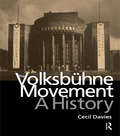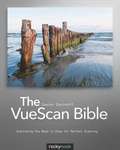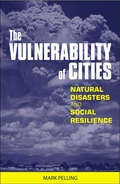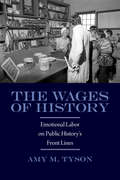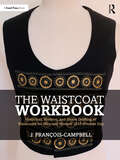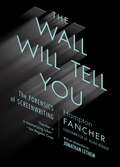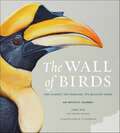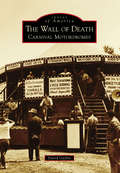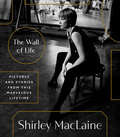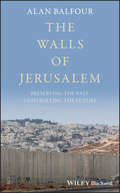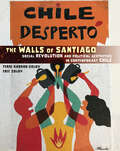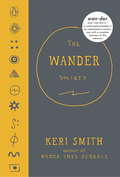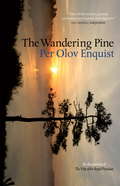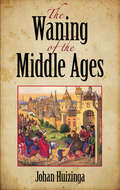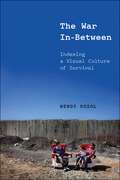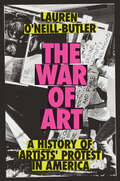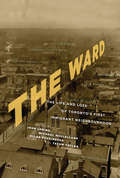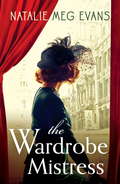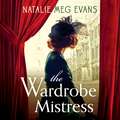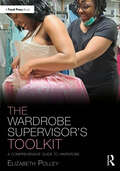- Table View
- List View
The Volksbuhne Movement: A History
by Cecil DaviesThis publication is the first comprehensive account in English of the history of the Freie Volksb^D"hne, founded in Berlin in 1890 through the interaction of Social Democracy and Theatrical Naturalism. Cecil Davies details the nationwide growth of the Volksb^D"hne Movement during the 1920s through the 1990s - including Germany's stormy history up to World War I, the problems associated with building the Volksbühne's own theatre, and the reunification of Germany. Weight is given to the contributions of major figures in the movement such as Bruno Wille, Siegfried Nestriepke, and Erwin Piscator.
The VueScan Bible
by Sascha SteinhoffVueScan is the world's most widely used software interface for digitizing film and prints on flatbed and film scanners. This powerful yet affordable program supports over 1500 scanners and 321 digital camera RAW file types, and is available for Mac OS X, Windows, and Linux. Much more than a simple scanner program, VueScan allows you to perform functions such as color restoration, adding sharpening filters, adjusting white balance, rotating images, and batch scanning multiple images. It also provides output to a variety of formats including TIFF, JPEG, and searchable PDF files (even all three simultaneously). The Pro version outputs to the RAW format and provides options for color adjustments, and more. Despite its popularity, the documentation for VueScan does not provide enough information to use the full power of the system and makes it difficult to get started. The VueScan Bible is the missing manual for new, experienced, and prospective users of VueScan.
The Vulnerability of Cities: Natural Disasters and Social Resilience
by Mark PellingWhen disaster strikes in cities the effects can be catastrophic compared to other environments. But what factors actually determine the vulnerability or resilience of cities? The Vulnerability of Cities fills a vital gap in disaster studies by examining the too-often overlooked impact of disasters on cities, the conditions leading to high losses from urban disasters and why some households and communities withstand disaster more effectively than others. Mark Pelling takes a fresh look at the literature on disasters and urbanization in light of recent catastrophes. He presents three detailed studies of cities in the global South, drawn from countries with contrasting political and developmental contexts: Bridgetown, Barbados - a liberal democracy; Georgetown, Guyana - a post socialist-state; and Santo Domingo, Dominican Republic - an authoritarian state in democratic transition. This book demonstrates that strengthening local capacity - through appropriate housing, disaster-preparedness, infrastructure and livelihoods - is crucial to improving civic resilience to disasters. Equally important are strong partnerships between local community-based organizations, external non-governmental and governmental organizations, public and private sectors and between city and national government. The author highlights and discusses these best practices for handling urban disasters. With rapid urbanization across the globe, this book is a must-read for professionals, policy-makers, students and researchers in disaster management, urban development and planning, transport planning, architecture, social studies and earth sciences.
The Wages Of History: Emotional Labor On Public History's Front Lines (Public History In Historical Perspective Ser.)
by Amy M. TysonAnyone who has encountered costumed workers at a living history museum may well have wondered what their jobs are like, churning butter or firing muskets while dressed in period clothing. In The Wages of History, Amy Tyson enters the world of the public history interpreters at Minnesota's Historic Fort Snelling to investigate how they understand their roles and experience their daily work. Drawing on archival research, personal interviews, and participant observation, she reframes the current discourse on history museums by analyzing interpreters as laborers within the larger service and knowledge economies. <p><p> Although many who are drawn to such work initially see it as a privilege—an opportunity to connect with the public in meaningful ways through the medium of history—the realities of the job almost inevitably alter that view. Not only do interpreters make considerable sacrifices, both emotional and financial, in order to pursue their work, but their sense of special status can lead them to avoid confronting troubling conditions on the job, at times fueling tensions in the workplace. <p> This case study also offers insights—many drawn from the author's seven years of working as an interpreter at Fort Snelling—into the way gendered roles and behaviors from the past play out among the workers, the importance of creative autonomy to historical interpreters, and the ways those on public history's front lines both resist and embrace the site's more difficult and painful histories relating to slavery and American Indian genocide.
The Waistcoat Workbook: Historical, Modern and Genre Drafting of Waistcoats for Men and Women 1837 – Present Day
by J. François-CampbellThe Waistcoat Workbook: Historical, Modern, and Genre Drafting of Waistcoats for Men and Women 1837–Present Day provides comprehensive coverage of the design, construction, and role of waistcoats from the reign of Queen Victoria to the present day in the United Kingdom.The book contains step-by-step instructions on how to draft the garments onto pattern paper from start to finish with drafting tools, including diagrams and detailed instructions on what measurements are required and how to record the information. The book also features: A brief history of waistcoats in European, and particularly British history, highlighting key points in the evolution of the garment A discussion of fabrics that would be suitable to use for the garments and what kind of interlinings and linings are best suited, depending on the main fabric chosen for the front of the garment Information on how to deal with one and two-way fabrics and challenging materials, as well as fabric analysis and pressing techniques Step-by-step instructions to construct genre waistcoats, including cosplay and Steampunk clothing Industry terminology and suppliers and stockists The Waistcoat Workbook is an excellent resource for professional film and theatre costume makers and tailors, students of costume and fashion design, and makers in cosplay, Steampunk, and re-enactment fields.
The Wall Will Tell You: The Forensics of Screenwriting
by Hampton FancherA completely original guide to the screenwriter's art -- as only the writer of Blade Runner could concieve it.The master speaks, in this unique guide for screenwriters -- and writers and artists of all kinds. In short paragraphs--oracular and enigmatic, hardhitting and concrete--the man Forbes called a "creative genius" writes a guide book like none other for the aspiring screenwriter. Learn how to write living, breathing characters, exciting action and plot, and develop your own artistic vision. And learn how to never compromise that vision, most importantly, with yourself.
The Wall of Birds: One Planet, 243 Families, 375 Million Years
by Jane Kim Thayer WalkerA celebration of the diversity and evolution of birds, as depicted in the Cornell Lab of Ornithology's magnificent 2,500-square-foot Wall of Birds mural by artist Jane Kim.Part homage, part artistic and sociological journey, The Wall of Birds tells the story of birds' remarkable 375-million-year evolution. With a foreword by John W. Fitzpatrick, director of the Cornell Lab of Ornithology, and full of lush photographs of gorgeous life-size birds painted in exacting detail, The Wall of Birds lets readers explore these amazing creatures family by family and continent by continent. Throughout, beautifully crafted narratives and intimate artistic reflections tell of the evolutionary forces that created birds' dazzling variety of forms and colors, and reveal powerful lessons about birds that are surprisingly relevant to contemporary human challenges.From the tiny five-inch Marvelous Spatuletail hummingbird to the monstrous thirty-foot Yutyrannus, The Wall of Birds is a visual feast, essential for bird enthusiasts, naturalists, and art lovers alike.
The Wall of Death: Carnival Motordromes
by David GaylinIn 1911, the operators of Coney Island�s Luna Park premiered a miniature, radically banked racetrack for staged automobile races that seemed to defy gravity. For a fee, patrons would watch from the perimeter of the 85-foot wooden saucer as daredevil drivers raced on the steep angle of the tiny track. The attraction created a sensation and was quickly copied with a show that featured motorcycle riders performing breathtaking stunts. When portable versions were made available, every traveling carnival owner in the United States rushed to have one. Motordromes with perfectly vertical walls soon followed, which permitted riders on their Indian motorcycles to climb, sometimes to a height of 20 feet, with nothing but centrifugal force between them and a trip to the trauma ward. And when full-grown lions were added to pursue riders in the arena, no one could resist buying a ticket! The �Wall of Death,� a name these shows received in 1917, remained a staple attraction on American carnival midways until the 1970s.
The Wall of Life: Pictures and Stories from This Marvelous Lifetime
by Shirley MacLaineAcademy Award-winning actress and New York Times bestselling author Shirley MacLaine shares a dazzling memoir in photographs, chronicling her extraordinary life with 150+ images from her personal archiveWith more than seventy years on the silver screen, Shirley MacLaine has, as she says, seen it all, done it all, been everywhere, and met everyone. Since making her Hollywood debut in 1955, her popularity has only grown as she&’s amassed a stunning collection of awards and written multiple bestselling memoirs.Now, at ninety years old, MacLaine has more stories to tell and the pictures to bring them to life. By introducing readers to her extensive photo collection—which she calls her &“wall of life&”—MacLaine reveals both intimate family memories and images with some of the most significant figures from entertainment and politics. With wit and charm, she reflects on each photo, exploring ambition, love, friendship, motherhood, art, political activism, curiosity, and more.Charting the course of her remarkable life and career, MacLaine shares both early memories (her childhood with her brother, Warren Beatty; her decision to leave for New York City at age sixteen; her early work dancing on Broadway) as well as remembrances of her days in the public eye (campaigning for George McGovern, traveling to meet political luminaries, starring in legendary film roles, and developing an interest in spirituality).Along the way, readers gain greater insight into figures such as Frank Sinatra, Dean Martin, Bob Fosse, Jack Nicholson, the Dalai Lama, Fidel Castro, Mikhail Baryshnikov, and many more. Whether she's sharing what advice Elvis Presley asked her for, how she consoled close friend Elizabeth Taylor after the death of her husband, or which head of state she discussed UFOs with, MacLaine offers her most visual and delightful book yet, giving readers an unprecedented glance into a life like no other.
The Walls of Jerusalem: Preserving the Past, Controlling the Future
by Alan BalfourA complete examination of the men and forces that created and shaped the modern state of Israel over the last hundred years Walls of Jerusalem is a study of the creation and evolution of the modern state of Israel. This unique work begins with the actions of four extraordinary men — Theodor Herzl, Chaim Weizmann, Ze’ev Jabotinsky, and David Ben-Gurion — and follows with their influence on subsequent leaders and on the political and military decisions that have shaped and changed Jerusalem and the nation. The resulting physical realty has made concrete the shift in vison from the broad utopian ideals of the beginning, to the separation barrier and settlement enclaves that increasingly divide both Jewish and Palestinian cultures. The author traveled across the West Bank, into the Israeli settlements and along the Israeli security barrier dividing Israel from Palestine. He entered the tombs, mosques and synagogues, experienced the distortion of Jerusalem since the building of the separation barrier - the watchtowers, the welded gates, the shuttered shops, divided highways and back-ways, tunnels, bridges, checkpoints, to better understand evolving reality that defines the stage for the future relationship between Israel and Palestine. Walls of Jerusalem is a timely book, its vivid narrative journeys through a century and a half of dreams and conflicts that lead to a divided Jerusalem: It presents each stage of Israel’s evolution, from the 1896 publication of Herzl’s Der Judenstaat and the Balfour Declaration, to the opening of the United States embassy in Jerusalem in 2018 Relates the visions of Israel’s creators to the destructive and constructive forces utilized to create a new nation Reviews the century long attempts by international organizations to resolve the conflict between Jews and Palestinians Makes every effort to present a balanced exploration of challenges facing the state of Israel and its place on the world stage, but in conclusion gives emphasis to the plight of the Palestinians Integrates illustrations with text to provide a detailed portrait of central figures in modern Israel’s history
The Walls of Santiago: Social Revolution and Political Aesthetics in Contemporary Chile (Protest, Culture & Society #30)
by Eric Zolov Terri Gordon-ZolovA photo-illustrated record of Chilean protest art, along with reflections on artistic antecedents, global protest movements, and the long shadow cast by Chile’s authoritarian past. “This is an excellent and unique contribution to our understanding of protest art. It is the first substantive treatment in English of an important social movement and a significant contribution to the political impact of the COVID-19 pandemic.”—T.V. Reed, Washington State University From October 2019 until the COVID-19 lockdown in March 2020, Chile was convulsed by protests and political upheaval, as what began as civil disobedience transformed into a vast resistance movement. Throughout, the most striking aspects of the protests were the murals, graffiti, and other political graphics that became ubiquitous in Chilean cities. Authors Terri Gordon-Zolov and Eric Zolov were in Santiago to witness and document the protests from their very beginning. The book is beautifully illustrated with over 150 photographs taken throughout the protests. Additional photos will be available on the publisher’s website. From the introduction: In the conclusion, we take stock of the crisis of the nation-state in the contemporary era. This chapter brings events into the present moment, noting the ways President Piñera took advantage of the COVID-19 pandemic to reclaim the streets of Santiago, a phenomenon echoed in countries across the globe. While most of the global protest movements were forced to go underground (or into the ether), the Black Lives Matter movement surged in the United States and drew massive amounts of support both domestically and abroad, suggesting a continued wave of grassroots protests. We close with reflections on the continued relevance of walls in a virtual world, the testimonial role that protest graphics play, and the future outlook for revolutionary movements in Chile and worldwide.
The Wander Society
by Keri Smithwan·der verb \ˈwän-dər\ to walk/explore/amble in an unplanned or aimless way with a complete openness to the unknown Several years ago when Keri Smith, bestselling author of Wreck This Journal, discovered cryptic handwritten notations in a worn copy of Walt Whitman's Leaves of Grass, her interest was piqued. Little did she know at the time that those simple markings would become the basis of a years-long, life-changing exploration into a mysterious group known only as The Wander Society, as well as the subject of this book.Within these pages, you'll find the results of Smith's research: A guide to the Wander Society, a secretive group that holds up the act of wandering, or unplanned exploring, as a way of life. You'll learn about the group's mysterious origins, meet fellow wanderers through time, discover how wandering feeds the creative mind, and learn how to best practice the art of wandering, should you choose to accept the mission.From the Hardcover edition.
The Wandering Pine: Life as a Novel
by Per Olov EnquistWhen everything began so well, how could it turn out so badly? A blisteringly frank autobiographical novel by Sweden's great man of letters - for readers of K. O. Knausgaard's My Struggle."Some life. Some novel . . . Wonderful, brave, evocative . . . It is a remarkable story, and Enquist is remarkably frank in narrating every last detail" HeraldWhat was it about Hjoggböle, a farming village in the northernmost part of Sweden, that created so many idiots - and writers? There was nothing to indicate that P.O. Enquist would be stricken by an addiction to writing. Nothing in his family - honest, hardworking people. Not a trace of poetry. And yet he worked his way, via journalism, novels and plays, to the centre of Swedish politics and cultural life. His books garnered prize after prize. His plays ran for decades and premiered on Broadway. Why then, living with a new wife in Paris, does he hole up in their palatial Champes-Élysées apartment, talking only to his cat? How is it that he wakes to find himself in an uncoupled carriage on a railway siding in Hamburg, two - or was it three? - days after the first-night party finished? And what is it that drives him to run shoeless through the deep January snow of an Icelandic plain, leaving the lights of the drying out clinic far behind? Narrating in the third person, as if he were merely a character in the eventful, perplexing and ultimately triumphantly redemptive drama of his own life, P.O. Enquist is as elliptical as Karl Ove Knausgaard is exhaustive. Clear-eyed, rueful, written with elegance and humour, this is the singular story of a remarkable man.
The Waning of the Middle Ages
by Johan HuizingaThis classic study of art, life, and thought in France and the Netherlands during the fourteenth and fifteenth centuries ranks as one of the most perceptive analyses of the medieval period. A brilliantly creative work that established the reputation of Dutch historian John Huizinga (1872-1945), the book argues that the era of diminishing chivalry reflected the spirit of an age and that its figures and events were neither a prelude to the Renaissance nor harbingers of a coming culture, but a consummation of the old.Among other topics, the author examines the violent tenor of medieval life, the idea of chivalry, the conventions of love, religious life, the vision of death, the symbolism that pervaded medieval life, and aesthetic sentiment. We view the late Middle Ages through the psychology and thought of artists, theologians, poets, court chroniclers, princes, and statesmen of the period, witnessing the splendor and simplicity of medieval life, its courtesy and cruelty, its idyllic vision of life, despair and mysticism, religious, artistic, and practical life, and much more. Long regarded as a landmark of historical scholarship, The Waning of the Middle Ages is also a remarkable work of literature. Of its author, the New York Times said, "Professor Huizinga has dressed his imposing and variegated assemblage of facts in the colorful garments characteristic of novels, and he parades them from his first page to the last in a vivid style."An international success following its original publication in 1919 and subsequently translated into several languages, The Waning of the Middle Ages will not only serve as an invaluable reference for students and scholars of medieval history but will also appeal to general readers and anyone fascinated by life during the Middle Ages.
The Waning of the Middle Ages
by Johan HuizingaThis classic study of art, life, and thought in France and the Netherlands during the fourteenth and fifteenth centuries ranks as one of the most perceptive analyses of the medieval period. A brilliantly creative work that established the reputation of Dutch historian John Huizinga (1872-1945), the book argues that the era of diminishing chivalry reflected the spirit of an age and that its figures and events were neither a prelude to the Renaissance nor harbingers of a coming culture, but a consummation of the old.Among other topics, the author examines the violent tenor of medieval life, the idea of chivalry, the conventions of love, religious life, the vision of death, the symbolism that pervaded medieval life, and aesthetic sentiment. We view the late Middle Ages through the psychology and thought of artists, theologians, poets, court chroniclers, princes, and statesmen of the period, witnessing the splendor and simplicity of medieval life, its courtesy and cruelty, its idyllic vision of life, despair and mysticism, religious, artistic, and practical life, and much more. Long regarded as a landmark of historical scholarship, The Waning of the Middle Ages is also a remarkable work of literature. Of its author, the New York Times said, "Professor Huizinga has dressed his imposing and variegated assemblage of facts in the colorful garments characteristic of novels, and he parades them from his first page to the last in a vivid style."An international success following its original publication in 1919 and subsequently translated into several languages, The Waning of the Middle Ages will not only serve as an invaluable reference for students and scholars of medieval history but will also appeal to general readers and anyone fascinated by life during the Middle Ages.
The Waning of the Middle Ages
by Johan HuizingaThis classic study of art, life, and thought in France and the Netherlands during the fourteenth and fifteenth centuries ranks as one of the most perceptive analyses of the medieval period. A brilliantly creative work that established the reputation of Dutch historian John Huizinga (1872-1945), the book argues that the era of diminishing chivalry reflected the spirit of an age and that its figures and events were neither a prelude to the Renaissance nor harbingers of a coming culture, but a consummation of the old.Among other topics, the author examines the violent tenor of medieval life, the idea of chivalry, the conventions of love, religious life, the vision of death, the symbolism that pervaded medieval life, and aesthetic sentiment. We view the late Middle Ages through the psychology and thought of artists, theologians, poets, court chroniclers, princes, and statesmen of the period, witnessing the splendor and simplicity of medieval life, its courtesy and cruelty, its idyllic vision of life, despair and mysticism, religious, artistic, and practical life, and much more. Long regarded as a landmark of historical scholarship, The Waning of the Middle Ages is also a remarkable work of literature. Of its author, the New York Times said, "Professor Huizinga has dressed his imposing and variegated assemblage of facts in the colorful garments characteristic of novels, and he parades them from his first page to the last in a vivid style."An international success following its original publication in 1919 and subsequently translated into several languages, The Waning of the Middle Ages will not only serve as an invaluable reference for students and scholars of medieval history but will also appeal to general readers and anyone fascinated by life during the Middle Ages.
The Waning of the Middle Ages: A Study Of The Forms Of Life, Thought, And Art In France And The Netherlands In The Fourteenth And Fifteenth Centuries (Peregrine Bks.)
by Johan HuizingaThis classic study of art, life, and thought in France and the Netherlands during the fourteenth and fifteenth centuries ranks as one of the most perceptive analyses of the medieval period. A brilliantly creative work that established the reputation of Dutch historian John Huizinga (1872-1945), the book argues that the era of diminishing chivalry reflected the spirit of an age and that its figures and events were neither a prelude to the Renaissance nor harbingers of a coming culture, but a consummation of the old.Among other topics, the author examines the violent tenor of medieval life, the idea of chivalry, the conventions of love, religious life, the vision of death, the symbolism that pervaded medieval life, and aesthetic sentiment. We view the late Middle Ages through the psychology and thought of artists, theologians, poets, court chroniclers, princes, and statesmen of the period, witnessing the splendor and simplicity of medieval life, its courtesy and cruelty, its idyllic vision of life, despair and mysticism, religious, artistic, and practical life, and much more. Long regarded as a landmark of historical scholarship, The Waning of the Middle Ages is also a remarkable work of literature. Of its author, the New York Times said, "Professor Huizinga has dressed his imposing and variegated assemblage of facts in the colorful garments characteristic of novels, and he parades them from his first page to the last in a vivid style."An international success following its original publication in 1919 and subsequently translated into several languages, The Waning of the Middle Ages will not only serve as an invaluable reference for students and scholars of medieval history but will also appeal to general readers and anyone fascinated by life during the Middle Ages.
The War Against the BBC: How an Unprecedented Combination of Hostile Forces Is Destroying Britain's Greatest Cultural Institution... And Why You Should Care
by Patrick Barwise Peter YorkThere's a war on against the BBC. It is under threat as never before. And if we lose it, we won't get it back.The BBC is our most important cultural institution, our best-value entertainment provider, and the global face of Britain. It's our most trusted news source in a world of divisive disinformation. But it is facing relentless attacks by powerful commercial and political enemies, including deep funding cuts - much deeper than most people realise - with imminent further cuts threatened. This book busts the myths about the BBC and shows us how we can save it, before it's too late.
The War In-Between: Indexing a Visual Culture of Survival
by Wendy KozolExplores the ambiguities and contradictions that disrupt the assumed boundaries of battle zonesAgainst the fabric of suffering that unfolds around more spectacular injuries and deaths, The War In-Between studies visual depictions of banal, routine, or inscrutable aspects of militarized violence. Spaces of the in-between are both broader and much less visible than battlefields, even though struggles for survival arise out of the same conditions of structural violence. Visual artifacts including photographs, video, data visualizations, fabric art, and craft projects provide different vantage points on the quotidian impacts of militarism, whether it is the banality of everyday violence for non-combatants or the daily struggles of soldiers living with physical and emotional trauma.Three interrelated concepts frame the book’s attempt to “stay” in the moment of looking at visual cultures of survival. First, the concept of the war in-between captures those interstitial spaces of war where violence and survival persist side-by-side. Second, this book expands the concept of indexicality to consider how images of the in-between rely on a range of indexical traces to produce alternative visualities about survival and endurance. Third, the book introduces an asymptotic analysis to explore the value in getting close to the diverse experiences that comprise the war in-between, even if the horizon line of experience is always just out of reach.Exploring the capaciousness of survival reveals that there is more to feel and engage in war images than just mangled bodies, collapsing buildings, and industrialized death. The War In-Between, Kozol argues, offers not a better truth about war but an accounting of visualities that arise at the otherwise unthinkable junction of conflict and survival.
The War for Late Night
by Bill CarterThe New York Times bestselling author of The Late Shift delivers "a boisterous, two-timing, high-stakes drama about the business of comedy" (The Associated Press). No one is more uniquely suited to document television's latest late- night travesty than veteran media reporter and bestselling author, Bill Carter. NBC's CEO, Jeff Zucker, had it all worked out when he moved Jay Leno from behind the desk at The Tonight Show, and handed the reins over to Conan O'Brien. But as everyone knows, his decision was a spectacular failure. Ratings plummeted, affiliates were enraged-and when Zucker tried to put everything back the way it was, that plan backfired as well. In candid detail, Carter charts the vortex that sucked in-not just Leno and O'Brien-but also Letterman, Stewart, Fallon, Kimmel, and Ferguson as frantic agents and network executives tried to manage a tectonic shift in television's most beloved institution.
The War of Art: A History of Artists' Protest In America
by Lauren O'Neill-ButlerHow artists have changed America through direct actionArtists in America have long battled against injustices, believing that art can in fact &“do more.&” The War of Art tells this history of artist-led activism and the global political and aesthetic debates of the 1960s to the present. In contrast to the financialized art market and celebrity artists, the book explores the power of collective effort — from protesting to philanthropy, and from wheat pasting to planting a field of wheat.Lauren O&’Neill-Butler charts the post-war development of artists&’ protest and connects these struggles to a long tradition of feminism and civil rights activism. The book offers portraits of the key individuals and groups of artists who have campaigned for solidarity, housing, LGBTQ+, HIV/AIDS awareness, and against Indigenous injustice and the exclusion of women in the art world. This includes: the Black Emergency Cultural Coalition (BECC), Women Artists in Revolution (WAR), David Wojnarowicz&’s work with ACT UP, Top Value Television (TVTV), Agnes Denes, Edgar Heap of Birds, Dyke Action Machine! (DAM!), fierce pussy, Project Row Houses, and Nan Goldin&’s Prescription Addiction Intervention Now (PAIN).Based upon in-depth oral histories with the key figures in these movements, and illustrated throughout, The War of Art is an essential corrective to the idea that art history excludes politics.
The Ward
by Michael Mcclelland John Lorinc Ellen Scheinberg Tatum TaylorFrom the 1870s to the 1950s, waves of immigrants to Toronto - Irish, Jewish, Chinese and Italian, among others - landed in 'The Ward' in the centre of downtown. Deemed a slum, the area was crammed with derelict housing and 'ethnic' businesses; it was razed in the 1950s to make way for a grand civic plaza and modern city hall. Archival photos and contributions from a wide variety of voices finally tell the story of this complex neighbourhood and the lessons it offers about immigration and poverty in big cities. Contributors include historians, politicians, architects and descendents of Ward residents on subjects such as playgrounds, tuberculosis, bootlegging and Chinese laundries.With essays by Howard Akler, Denise Balkissoon, Steve Bulger, Jim Burant, Arlene Chan, Alina Chatterjee, Cathy Crowe, Richard Dennis, Ruth Frager, Richard Harris, Gaetan Heroux, Edward Keenan, Bruce Kidd, Mark Kingwell, Jack Lipinsky, John Lorinc, Shawn Micallef, Howard Moscoe, Laurie Monsebraaten, Terry Murray, Ratna Omidvar, Stephen Otto, Vincenzo Pietropaolo, Michael Posner, Michael Redhill, Victor Russell, Ellen Scheinberg, Sandra Shaul, Myer Siemiatycki, Mariana Valverde, Thelma Wheatley, Kristyn Wong-Tam and Paul Yee, among others.
The Wardrobe Mistress: An evocative historical romance of hidden secrets that will capture your heart
by Natalie Meg EvansLondon 1945. A young war widow steps aboard a train in search of a new life. Clutching the key to a mysterious inheritance, Vanessa Kingcourt can no longer resist the pull of the old Farren Theatre, which is in need of a Wardrobe Mistress. With no experience and no budget for supplies, Vanessa must use her intuition to create beautiful costumes from whatever scraps survived the blitz. It's a seemingly impossible task, and one which may unravel family secrets sewn deep into the very fabric of the London theatre scene. . .
The Wardrobe Mistress: An evocative historical romance of hidden secrets that will capture your heart
by Natalie Meg EvansFrom the award-winning author of The Dress Thief comes a love story set in the glittering world of London theatre. Perfect for fans of Gill Paul and Lucinda Riley.London 1945. A young war widow steps aboard a train in search of a new life. Clutching the key to a mysterious inheritance, Vanessa Kingcourt can no longer resist the pull of the old Farren Theatre - an enchanted place seeped in memories of her actor father.Now owned by troubled former captain Alistair Redenhall, The Farren is in need of a Wardrobe Mistress and a new lease of life. With no experience and no budget for supplies, Vanessa must use her intuition to create beautiful costumes from whatever scraps of silk and thread survived the blitz. It's a seemingly impossible task, but a welcome distraction as she struggles to resist her blossoming feelings for Alistair.What Vanessa discovers could unravel family secrets sewn deep into the very fabric of the London theatre scene . . . but will she repeat the same terrible mistakes her father made? And can she dare to love a man who will never be hers?(P)2019 Quercus Editions Limited
The Wardrobe Supervisor's Toolkit: A Comprehensive Guide to Wardrobe (The Focal Press Toolkit Series)
by Elizabeth PolleyThe Wardrobe Supervisor’s Toolkit: A Comprehensive Guide to Wardrobe is a complete resource for organizing and streamlining the wardrobe process for any live production, with tips and tricks to quickly and seamlessly dress performers for their next scene.This book offers a foundation for anyone wishing to improve their wardrobe skills, as well as specific steps for universities and theater companies to implement into their wardrobe process. Elizabeth Polley draws on professional experiences to provide clear directions, numerous examples, practical forms and lists, and advice for keeping calm and bringing order to backstage costume changes. This toolkit includes paperwork samples, quick-change tricks, laundry solutions, dress rehearsal recommendations, items to have in a wardrobe kit, and much more.This book is written for new and emerging Wardrobe professionals and costume shop managers, as well as students in technical theatre courses, including Costume Technology, Costume Design, Stage Management, and Production Management.
